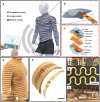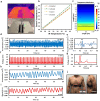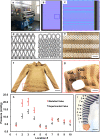A tailored, electronic textile conformable suit for large-scale spatiotemporal physiological sensing in vivo
- PMID: 38624354
- PMCID: PMC7222957
- DOI: 10.1038/s41528-020-0068-y
A tailored, electronic textile conformable suit for large-scale spatiotemporal physiological sensing in vivo
Abstract
The rapid advancement of electronic devices and fabrication technologies has further promoted the field of wearables and smart textiles. However, most of the current efforts in textile electronics focus on a single modality and cover a small area. Here, we have developed a tailored, electronic textile conformable suit (E-TeCS) to perform large-scale, multimodal physiological (temperature, heart rate, and respiration) sensing in vivo. This platform can be customized for various forms, sizes and functions using standard, accessible and high-throughput textile manufacturing and garment patterning techniques. Similar to a compression shirt, the soft and stretchable nature of the tailored E-TeCS allows intimate contact between electronics and the skin with a pressure value of around ~25 mmHg, allowing for physical comfort and improved precision of sensor readings on skin. The E-TeCS can detect skin temperature with an accuracy of 0.1 °C and a precision of 0.01 °C, as well as heart rate and respiration with a precision of 0.0012 m/s2 through mechano-acoustic inertial sensing. The knit textile electronics can be stretched up to 30% under 1000 cycles of stretching without significant degradation in mechanical and electrical performance. Experimental and theoretical investigations are conducted for each sensor modality along with performing the robustness of sensor-interconnects, washability, and breathability of the suit. Collective results suggest that our E-TeCS can simultaneously and wirelessly monitor 30 skin temperature nodes across the human body over an area of 1500 cm2, during seismocardiac events and respiration, as well as physical activity through inertial dynamics.
Keywords: Electrical and electronic engineering; Sensors and probes.
© The Author(s) 2020.
Conflict of interest statement
Competing interestsThe authors declare no competing interests.
Figures





References
-
- Choi, S., Lee, H., Ghaffari, R., Hyeon, T. & Kim, D. H. Recent Advances in flexible and stretchable bio-electronic devices integrated with nanomaterials. Adv. Mater.28, 4203–4218 (2016). - PubMed
-
- Dagdeviren, C. et al. Recent progress in flexible and stretchable piezoelectric devices for mechanical energy harvesting, sensing and actuation. Extreme Mech. Lett.10.1016/j.eml.2016.05.015 (2016).
-
- Rogers, J. A. Soft electronics for the human body. In 46thEuropean Solid-State Device Research Conference. Editions Frontieres (2016).
-
- Kim, D.-H. et al. Epidermal electronics. Science333, 838–843 (2011). - PubMed
-
- Tasnim, F. et al. Towards personalized medicine: the evolution of imperceptible health-care technologies. Foresight10.1108/FS-08-2018-0075 (2018).
LinkOut - more resources
Full Text Sources
Other Literature Sources
